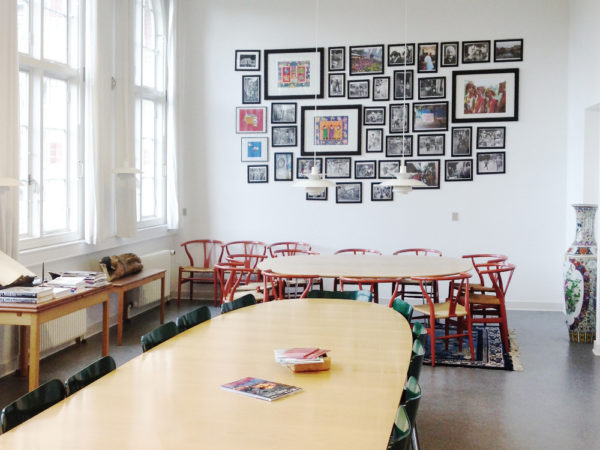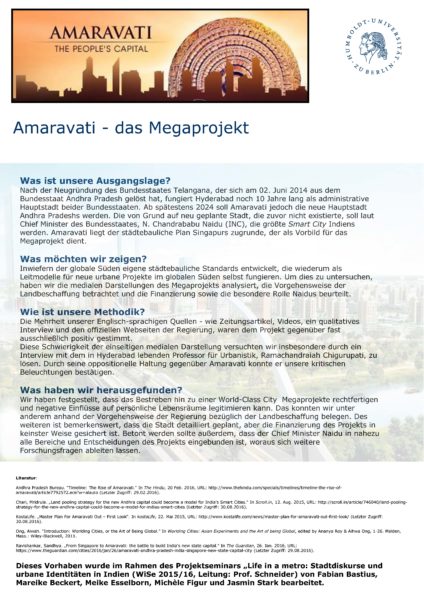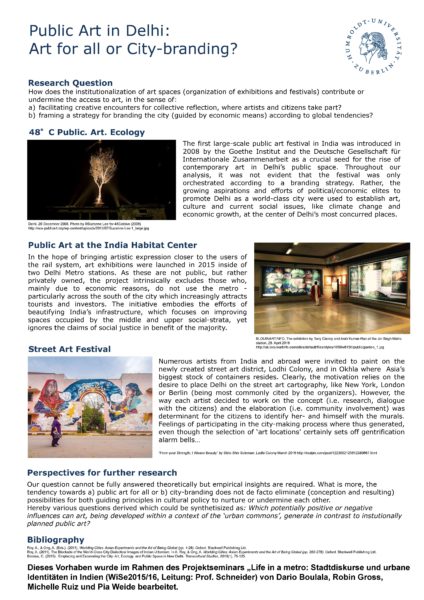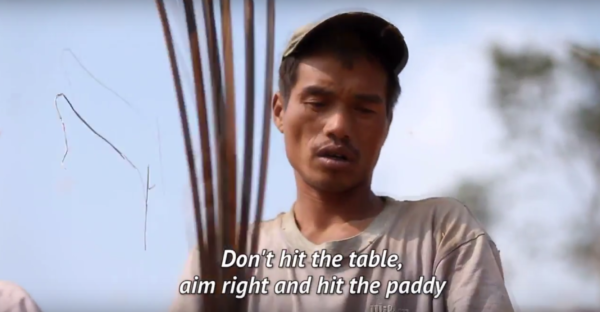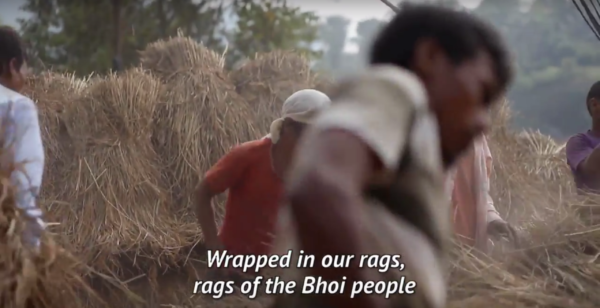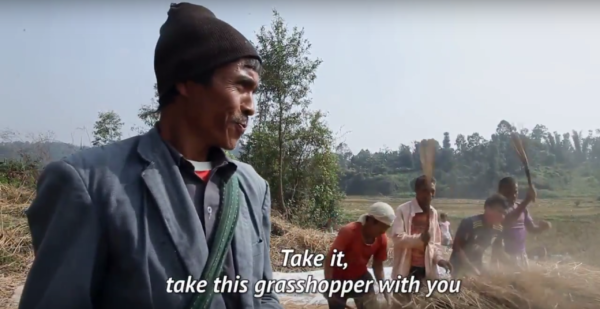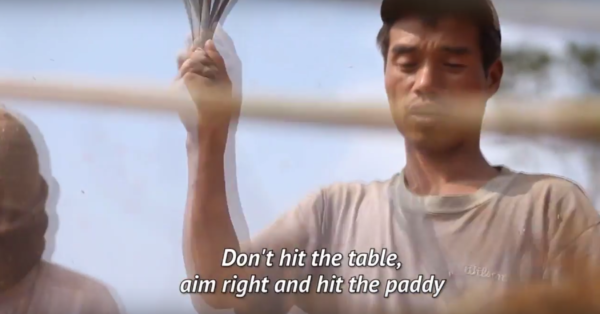Bilder und Text von Anna Oechslen (IAAW)
Alles ist im Fluss bei der diesjährigen Kochi-Muziris Biennale: Kurator Sudarshan Shetty hat sich von mythologischen Darstellungen Indiens als das Land der sieben Flüsse inspirieren lassen und möchte, dass auch die Kunstwerke und Konzepte in Bewegung sind, zusammenfließen und über den Zeitraum der Biennale hinausschwappen.
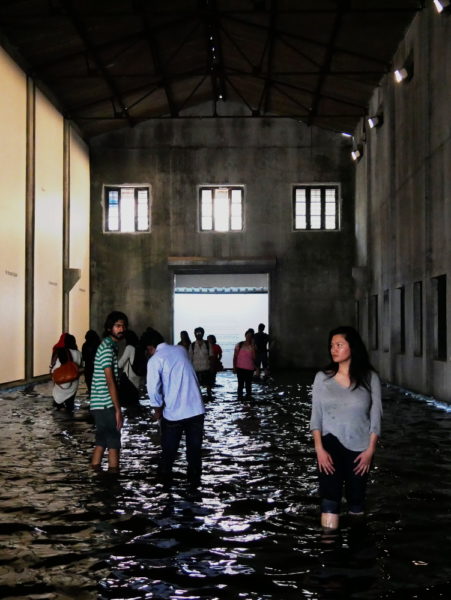
Noch bis 29. März präsentieren in Kochi im südindischen Bundesstaat Kerala 97 Künstler_innen aus 35 Ländern unter anderem Installationen, Fotografien, Videos und Performances. Es ist die dritte Auflage der größten Biennale Südasiens für zeitgenössische Kunst und sie trägt den Titel „Forming in the pupil of an eye“. Die Ausstellung verteilt sich auf zwölf Austragungsorte in der Stadt, dazu kommen noch zahlreiche kleinere Ausstellungen, die auch ohne Ticket zugänglich sind. Die Kunstwerke entfalten ihre Wirkung in bewusster Auseinandersetzung mit den Ausstellungsorten – einige der Künstler_innen nehmen die Geschichte der Räumlichkeiten auf oder lassen sich von den Materialien vor Ort inspirieren. Praneet Soi etwa hat für seinen Beitrag zur Biennale mit Kokosfaser experimentiert und daraus unter anderem Skulpturen im Innenhof des Pepper House geschaffen.
Das Meer spielt ebenfalls in einigen Arbeiten eine zentrale Rolle – dank der Lage an der Küste war manchmal nur ein geschickt platziertes Fenster nötig, um es zu integrieren. Auch die Besucher_innen werden immer wieder eingeladen, über die Rolle als bloße Betrachter_innen hinauszugehen, mit den Kunstwerken zu interagieren und manchmal sogar ganz wörtlich in sie einzutauchen: Raúl Zurita lässt das Publikum knietief durch Meerwasser zu seinem Gedicht The sea of pain waten und fügt den Worten über das Leid von Menschen auf der Flucht so eine weitere, körperliche Dimension hinzu. Die Kochi-Muziris Biennale versteht sich als people’s biennale – dementsprechend soll auch die lokale Bevölkerung mit einbezogen werden und ein Austausch stattfinden. Neben dem Haupt-Event veranstaltet die Kochi-Biennale Foundation das ganze Jahr über Vorträge, Workshops und Förderprogramme für Kunststudierende.
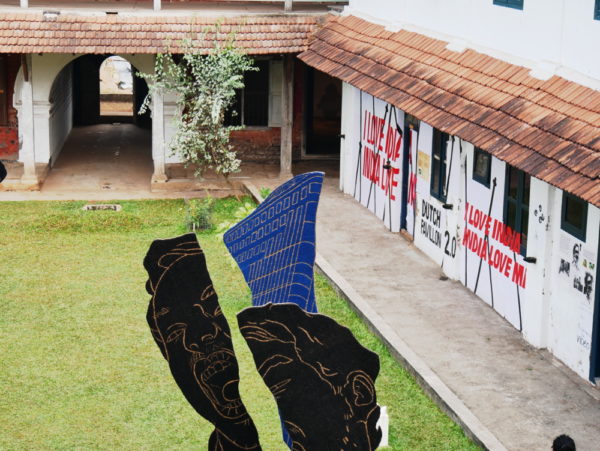
Seminar „Pop Diskurse: Hashtag Proteste, Popular Culture und (nicht-)akademische Wissensaushandlungen in aktuellen Medien“ Wintersemester 2016/17
Dozentin: Alexa Altmann
Ein Kurzfilm von Anh Thu Nguyen und Melanie Möller im Rahmen ihres Forschungsprojekts: „Female Graffiti und Streetart- Zwischen Kunst und Feminismus“
* Die Macherinnen des Films möchten darauf hinweisen, dass die hier gezeigten Stencils natürlich alle mit abwaschbaren Medien erstellt wurden!
Querschnittsbereich Medialität und Intermedialität in Asien und Afrika, Institut für Asien- und Afrikawissenschaften, Humboldt-Universität zu Berlin.
10.-11.12.2016: „Don’t Speak?! Kommunikation, Macht und Ohnmacht“
14.-15.01.2017: „Don’t tell me ‚cause it hurts?! Kritik, konstruktive Kritik, Feedback und Anerkennung“
Konzeption und Durchführung: Alexa Altmann

An den Wochenenden 10.-11. Dezember 2016 und 14.-15. Januar 2017 fanden zwei Workshops zu den Themen „Gewaltfreie Kommunikation und konstruktive Kritik“ am Querschnittsbereich Medialität und Intermedialität in Asien und Afrika des Instituts für Asien- und Afrikawissenschaften statt. Die Veranstaltung richtete sich an Studierende und Lehrende und widmete sich, sowohl der intensiven selbstreflexiven Auseinandersetzung mit Kommunikationswegen und Verständnissen, als auch der Erforschung und Stärkung gewaltfreier Konfliktbewältigungsstrategien und konstruktiver kritischer Teilnahme. Im Zuge des Workshops hinterfragten die Teilnehmer*innen auch Methoden der Konfliktbewältigung und entwickelten gemeinschaftlich Konzepte für den Umgang mit konstruktiver Kritik.
Der erste Teil des Workshops „Don’t Speak?! Kommunikation, Macht und Ohnmacht“ zentralisierte und problematisierte Kommunikation und Erfahrungen von Macht und Machtlosigkeit. Um eine offene und unbefangene Immersion in die Thematik zu ermöglichen, war der Auftakt des Workshops dem ungezwungen kommunikativen Austausch und dem Kennenlernen zwischen den Teilnehmer*innen gewidmet. Hierbei wurden sowohl Raum-, Körper- als auch Gruppendynamiktechniken und Übungen angewendet. Im Anschluss wurde zunächst der Begriff der Kommunikation gemeinsam hinterfragt und bestimmt. Positionen und Zuschreibungen, wie zum Beispiel Zuhörende und Sprechende, oder Expert*innen und Referent*innen, sowie Hierarchien und Gewalt in Kommunikationssituationen, wurden kritisch diskutiert. Ausgewählte und angepasste Methoden des Anti Bias-Ansatzes dienten der Sensibilisierung für die Verschränkungen struktureller Privilegien und institutioneller Diskriminierung in kommunikativen Interaktionen. Unterdrückungsformen, wie zum Beispiel Rassismus, Sexismus, Homophobie oder Klassismus, ihre Verschränkungen und Auswirkungen in Formen, auch nicht vorsätzlicher, verbaler und nonverbaler Gewalt, standen im Zentrum der regen und engagierten Auseinandersetzungen. Hierbei war die Reflektion eigener Erfahrungen des Diskriminierens, und Diskriminiertwerdens zentral. Die Situationsabhängigkeit von Subjektivität, Selbstwahrnehmungen und Zuschreibungen sowie der Unterschied zwischen persönlicher Ermächtigung und struktureller Benachteiligung wurden ebenfalls hervorgehoben.

1 ©privat Alexa Altmann
Der zweite Teil des Workshops „Don’t tell me ‚cause it hurts?! Kritik, konstruktive Kritik, Feedback und Anerkennung“ zentralisierte die Auseinandersetzung mit dem Begriff und der Funktion der Kritik. Hier unterschieden die Teilnehmer*innen zwischen konstruktiver Kritik und als persönlich verletzend bewerteten Äußerungen und hinterfragten defensive Reaktionen auf Feedbacks. Potentiell negative Assoziationen mit der Erfahrung des Kritisiertwerdens und Kritikübens wurden erforscht und in Beziehung zu Gefühlen von Macht und Machtlosigkeit gestellt. Hierbei war die Differenzierung von Bedürfnis-, Emotions- und Gedankenebenem im Sinne der gewaltfreien Kommunikation für die Teilnehmer*innen von ausschlaggebendem Interesse. Sowie auch die Reflexion von, z.B. gegenderten, Zuschreibungen und Erfahrungen in kommunikativen Austauschen.
Im Zuge der Workshops experimentierten die Teilnehmer*innen aktiv mit Konzepten der gewaltfreien Kommunikation und übertrugen sie gezielt auf die Formulierung und Anwendung konstruktiver Feedbacks. Insbesondere die gemeinschaftliche Sensibilisierung der Teilnehmer*innen bezüglich der Differenzierung zwischen wertschätzenden Aussagen und Lob, gegenseitigem in Schutz nehmen und anregender, selbstreflexiver Hinterfragung war von entscheidender Bedeutung. Die Wahrnehmung und Anwendung konstruktiver Kritik, sowohl als Feedback leistende und erhaltende Person, als Bereicherung, Angebot und Anerkennung wurde hier explizit angestrebt.
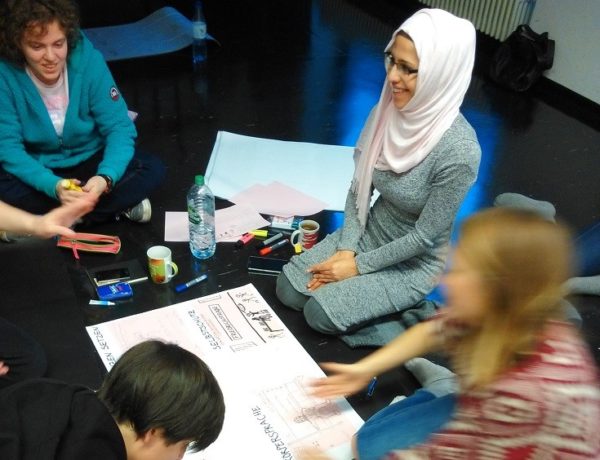
2 ©privat Alexa Altmann
Anstelle einer konsequent methodenorientierten Vorgehensweise, waren die Teilnehmer*Innen gefragt, mögliche „Rezepte“ der Konfliktresolution und gewaltfreien Kommunikation eigenständig zu reflektieren und zu problematisieren. Besonders die Möglichkeiten und Grenzen gewaltloser horizontaler Kommunikation – auch konkret innerhalb der realen Hierarchien der Seminarsituation – wurden intensiv diskutiert und mit eigenen Strategien auf unterschiedliche kreative Weise erprobt und durchgespielt. Die Teilnehmer*innen beteiligten und entwickelten im Rahmen des Workshops Gruppen- und Rollenspiele, inszenierte kurze Improvisationstücke und dokumentierten ihre Erkenntnisse und Überlegungen in gemeinschaftlichen Projekten, wie z.B. selbstgezeichneten Comics und digitalen Fotocomics. Im Anschluss an die Projekte reflektierten die Teilnehmer*innen Gruppendynamiken und persönliche Positionen in Bezug auf Entscheidungsfindungsprozesse und Rollen- und Aufgabenvergabe und experimentierten mit der Vermittlung konstruktiver Feedbacks an die anderen Teilnehmer*innen – und natürlich auch an mich, als Teamerin.
Der Workshop zeichnete sich durch die besonders engagierte, intensive und kreative Diskussions- und Mitgestaltungsbereitschaft und Freude der Teilnehmenden in einer gelösten und immersiven Atmosphäre aus. Die Teilnehmer*innen hoben in ihren Feedbacks mir gegenüber auch den Originalitätswert und die überaus positiven und ermächtigenden Erfahrungen der Veranstaltungen hervor. Für das mir gegenüber erbrachte Vertrauen, möchte ich mich bei der Veranstalterin, Frau Prof. Dr. Nadja-Christina Schneider, und den Teilnehmer*innen herzlich bedanken.
Alexa Altmann
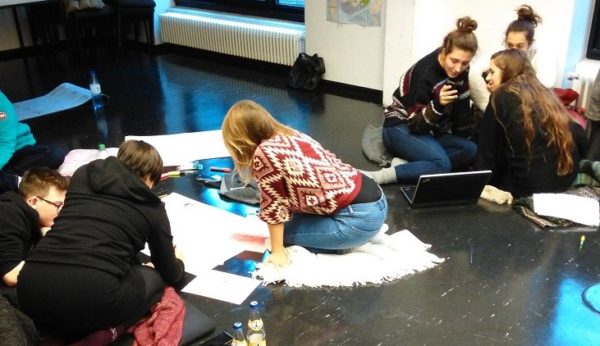
3 ©privat Alexa Altmann
Workspace and Support for Asia related Projects at NIAS, Copenhagen
a report by Mette Gabler
About the programme
Twice a year the Nordic Institute of Asian Studies (NIAS) is open for applications to join the NIAS team for two weeks (deadlines: June first and October first). Students mainly from universities belonging to the nordic NIAS Council (NNC) are invited to send in short project descriptions and if chosen, to work at the NIAS offices and gain access to resources and networks provided by the NIAS team. The focus is on supporting current work of Master students or Ph.D. candidates who’s work relates to Asian studies.
As part of the NIAS Support Programme for Asian Studies (NIAS SUPRA) that includes different forms of support towards researchers, the NIAS SUPRA Nordic scholarship is one of the most important features of NIAS. This scholarship includes the provision of a workspace at NIAS in Copenhagen, Denmark, and accommodation at the Nordisk Kollegium (Noko) including full board for two weeks. Students from institutions belonging to NNC will also have their travel expenses covered.
One particularly helpful feature of the NIAS SUPRA Nordic scholarship is the access to the NIAS‘ digital library and other resources through the NIAS Library and Information Centre (NIAS LINC), a specialised digital library servicing the Nordic Asian studies community, and the asiaportal. Through the IP address many materials from the University of Copenhagen and NIAS press are accessible and even open for download in PDF form (publications from NIAS press where available in print at a discount). In addition, a wish list for literature was sent before arrival and accommodated by the NIAS staff, providing me with a pyramid of books to be reviewed. This secured an easy start and perfect foundation for productive work.
My stay at NIAS
I arrived at the NIAS offices early Monday morning on September 26 with my stay to end October 9, and was greeted by one of the NIAS student assistants that coordinate the stay of and communicate with the SUPRA students (always in pairs, me and a colleague from Norway) before and during the stay. The arrival was signified by a welcoming nature and friendliness. The communication prior to the stay was comprehensive, informative and helpful, and in combination with the introduction to the offices and staff provided an energising environment.
During the first week, each of the SUPRA students presented their work during the “Lunch Talk”. This is a chance to share the topic including current questions and issues with the staff and researchers at NIAS, and in turn get constructive feedback and suggestions for further steps to take.
Throughout the stay, I was welcome to attend any of the events that were hosted by NIAS, including presentations and programs focussing on topics related to Asian studies. Among them a presentation by the former Foreign Minister of the Republic of Indonesia H.E. Dr. Hassan Wirajuda on the South China Sea dispute (Who Controls Murky Waters in the South China Sea?) followed by other expert speakers and an open discussion between the participants and the audiences, and a full-day program with presentations and discussions between colleague from Fudan University and University of Copenhagen on China’s New Diplomacy and voices emerging through Chinese social media.
I thoroughly enjoyed my stay at NIAS. Due to a highly comfortable workspace and very helpful people, the environment and input motivated my work and enabled me to move forward.
(picture by Mette Gabler)
Vortrag von Anna Oechslen im Rahmen des Workshops „Reflections on the Digital: Neoliberalism, Free Speech and Resistance“, am Tata Institute for Social Sciences, Mumbai, 1.-2. September 2016
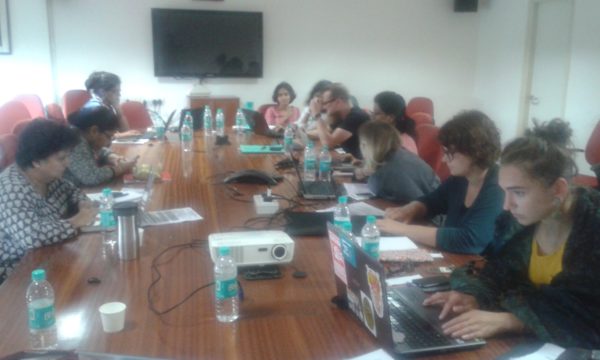
Digitale Medien bieten sozialen Bewegungen ganz neue Möglichkeiten, sich auch Regionen übergreifend zu vernetzen, sich Gehör zu verschaffen und dominanten Versionen der Wirklichkeit ihre eigenen Interpretationen entgegenzusetzen. Andererseits müssen Aktivist_innen neue Wege finden, mit den neoliberalen Strukturen etwa sozialer Netzwerke umzugehen. Darüber diskutierten Studierende, Promovierende und Lehrende aus Berlin, Leipzig und Mumbai Anfang September bei einem zweitägigen Workshop am Tata Institute for Social Sciences, (TISS) in Mumbai. Die Beiträge rückten verschiedene Aspekte des Themas ins Blickfeld, darunter das Zusammenwirken von Protesten im Internet und auf der Straße, Repräsentationen von Frauenkörpern in digitalen Räumen und Studierendenbewegungen in Deutschland und Indien. Im letzten Teil des Workshops diskutierten die Teilnehmer_innen die aufgeworfenen Fragen mit Interessierten von außerhalb auf Twitter (die Diskussion ist online abrufbar unter https://storify.com/fritzititzi/transdigi).

Anna Oechslen beschäftigte sich in ihrem Beitrag mit den Spannungen, die sich daraus ergeben, von Deutschland aus über Gender-Ungleichheiten in Indien zu forschen. Als Zugang zum Thema dienten dabei der Diskurs über Frauen und Sicherheit im urbanen Indien und die Aktivistinnen von ‚Pinjra Tod‘, die in Delhi gegen Gender-Diskriminierung auf dem Campus kämpfen. Durch das Internet als Informationsquelle ist es leichter geworden, auch über große Distanzen hinweg ethnografische Forschung zu betreiben. Gleichzeitig ist gerade das Thema Frauenrechte durch koloniale Diskurse und problematische Repräsentationen der ‚Third World Woman‘ aufgeladen; zur räumlichen Distanz tritt also eine Verwobenheit mit globalen Asymmetrien in der Wissensproduktion. Anhand ihrer eigenen Erfahrungen während der Forschung zu ihrer Masterarbeit zeigte Anna Oechslen, wo sie mit diesen Spannungen konfrontiert wurde und wie sie versuchte, ihnen zu begegnen. Die anschließende Diskussion machte deutlich, dass man nicht unbedingt in einem anderen Land sein muss, um diesen Problemen zu begegnen: Teilnehmer_innen berichteten etwa von ihren Erfahrungen aus der journalistischen Praxis und der Forschung zu ländlichen Räumen Indiens.
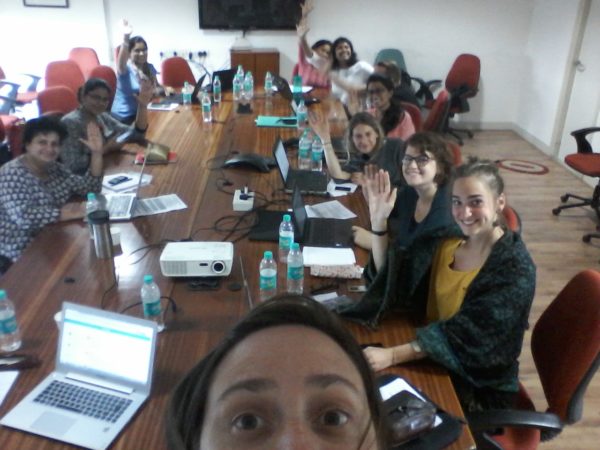
Max Arne Kramer
Brief Life of Insects, Escaping Museums – Lak(h)empong Diaries, Sounds from the Truck Country and Kings Have Their Resorts, People Have Their Songs. These four titles of a series of six documentary films make you instantly wonder what may hold them together. Looking for orientation you could read the title of the film-series again – Songs to Live By – and perhaps find a synopsis saying that the films are dealing with indigenous communities in the North East of India. Perhaps you are even more puzzled now by the range of associations from fauna via commerce to state-institutions.
In some ways this series is an exploration of a new form of documentary by Shillong based Hindi poet, filmmaker and editor Tarun Bhartiya. His former filmic engagements include When the Hens Crow (2013) and Darjeeling Himalayan Railway (2010). He won the Indian National Film Award in editing for his work In Camera (2009). The two films he edited for Sanjay Kak Jashn-e-Azadi (2007) and Red Ants Dream (2013) are significant contributions to a cinema of resistance against the state driven violence in Kashmir and in the jungles of Odisha. Both films show a highly contextualized variation between ‚distancing effects’ and more realist representations of political struggle.
With the series on the North-East Bhartiya is exploring new grounds, both formally and in terms of a politics of representation. The titles already suggest that the series produced by the Meghalay Government Department of Arts and Culture is in some ways neither about art nor about culture. At least not in the way most of us would imagine a film to be about a culture or about a form of art. We may more fruitfully engage with this series as an attempt to take a close look at various song-performances and what they tell us about history, memory, power, and social transformation.
The songs seem to be part of a fragile memory that is fading in the rapidly changing societies of the North East. To give one example from the first film of the series „The Brief Life of Insects“. The farmer and musician Albinus Karkongor cannot remember a song he sang threshing paddy just a few months after the filmmaker captured a first performance of the paddy-song and asked him to sing it again for the camera. Even a recording that Bhartiya has done with his mobile phone was of no help to make Albinus remember the lyrics. The song was embedded into a bodily memory of the work on the field which is beautifully captured by the camera and the editing evoking the rhythm of the threshing while portraying the dynamics of the collective work.
In the last film of the cycle „Kings Have Their Resorts, People Have Their Songs“ the song Long Hai was restaged partly for the camera. A woman from Syndai asks: How can we preserve the song if we don’t cultivate millet. A voice from the side of the camera (perhaps the filmmaker) answers: You don’t have to actually cultivate millet. The song or tradition that has faded or is about to fade opens up questions of archive and preservation: who is recording for whom? Since hardly any written source exists in these oral traditions one further question becomes particularly interesting: what is the role of documentary film as an archive of these practices?
All films of the series are formally invested in the multi-sensorial experiences which go into the collective performances of these mostly work-related songs. There is the constant strive for gathering a sensibility not only of the particular – and sometimes lost – ritual context, but also of the films entanglement in the actualities that are produced through the camera. These interventions of the filmmaker are marked through subtle editing strategies that suggest how the presence of the film team re-invoked a ritual context gone by.
While the ritual setting of the Long Hai song was dependent on the harvest of millet, we see a group of women and men discussing how difficult it would be to re-stage this tradition in a time where betel nuts are produced for profit in Syndai. A telephone call from Shillong, the capital of Meghalaya, is signalling the distance of the filmmaker from the everyday context of Syndai and his interest to record something that is no longer practiced. However, some voices in his films make clear that what is gone is an absence that is felt as a lack. The new betel work has suspended a system of voluntary exchange of labour that has been central to the meaning of Long Hai. The films point towards a number of processes of commodification that have transformed the basis of living amongst the communities.
I understand this as the intervention of the filmmaker into a fragile memory. The camera gets entangled in the collective desire to restage something that is lost. But that ‘something’ is not framed within the familiar notion of culture as the way of life of a classifiable group. Instead, Bhartiyas films mobilise a lack from with-out by articulating an aesthetic potential of communality in a sceptical and always curious voice.
The titles of the films are:
- BRIEF LIFE OF INSECTS
22 mins | Ktien Nongtung with English subtitles
- LOVE SONGS OF SOTJAK AND RINGJENG
17 mins | A.chik with English subtitles
- ESCAPING MUSEUMS – LAK(H)EMPONG DIARIES
29 mins | Ktien Nongtung and Sohra Khasi with English subtitles
- SONGS & SECRETS IN SADOLPARA
20 mins | A.chik with English subtitles
- SOUNDS FROM THE TRUCK COUNTRY
39 mins | Pnar with English subtitles
- KINGS HAVE THEIR RESORTS, PEOPLE HAVE THEIR SONGS
40 mins | War Jaintia & Pnar with English subtitles
Nina Khan (HU Berlin) und Menusha de Silva (National University of Singapore) im Rahmen des Trouble Shooting Lab der Konferenz „Diversity Encounters. Intersectional and Post-Colonial Perspectives“, 24.-26. Mai 2016, Humboldt-Universität zu Berlin und National University of Singapore (NUS)
The joint conference dealt with the impact migrants make on the multicultural and multiracial dimensions of cities in Asia and Europe. Criticizing the East-West divide and the focus on ‘difference’ and ‘otherness’ in otherwise insightful academic publications on this matter, the conference aimed at developing a collaborative perspective by bringing together researchers from the East (NUS) and the West (HU Berlin) for reflecting and discussing each other’s research. This exchange was especially evident in the “Trouble Shooting Lab” for which three tandems were created, consisting of one PhD student from HU Berlin and one from NUS in each case. They exchanged information about their research and prepared a joint paper on common challenges in their projects and on how they could learn from each other’s case study.
In their presentation, Nina Khan and Menusha de Silva gave a short introduction to their respective research projects, highlighted the commonality in their studies and discussed some methodological challenges.
Menusha de Silva’s work examines the migration histories of retired Sri Lankan immigrants in the UK, their experiences of return to Sri Lanka for retirement, and the manner they negotiate their dual entitlements (mostly through dual citizenship) and sense of belonging in two countries in order create an ideal transnational retirement. Nina Khan’s research focuses on the “New Donor” India or rather “development partner”, as it prefers to be called, and its development discourse in particular. Against the background of India’s own experience as a recipient country and a former colonized country of the Global South, the question arises how this might impact its development discourse and whether this will form an alternative to the (until today) hierarchical western development discourse.
The common ground of these two research projects is the postcolonial lens. The key angle which is being taking is how today’s perspectives and knowledge of the world are still influenced by colonial time discourses of the North-South binary. We tried to reflect on how the Asian and European gaze is inherent in both ours studies. Considering the European gaze in Menusha de Silva’s work, most of the retired migrants interviewed shared the manner their encounters with the predominantly-White population in the UK made them aware of their inferior social location. Regarding the Asian gaze on the other hand, the migrants who returned to Sri Lanka for retirement experienced negative encounters with the culturally and religiously similar local population. These exclusions are due to the disparity between their transnational identities and the Sri Lankan society’s notion of the national subject. In Nina Khan’s study, India challenges the Western gaze on the South, which is still inherent in today’s dominant development discourse. It questions the dominant European (or rather Western) gaze or discourse and the binary of the giving, charitable and progressive North and the needy, receiving and “backward” South. By focusing on India’s donor status, the research intends to move away from the stereotypical portrayal of India as the “underdeveloped” recipient country in development cooperation.
The discussion on methodological challenges revolved around how the respective positionality as a student from a European/Asian academic institution (or traditional Western donor country) might influence the openness of interview partners. For example, a large proportion of retired migrants living in Sri Lanka conveyed their distrust of Western institutions, which they perceived to be circulating negative views of Sri Lanka. Within this background, the affiliation to a non-Western university was viewed as a neutral position by the participants and enabled a greater level of trust. Depending on the status of the interview partners (retired migrants, Indian government officials) and the larger context of the research, this positionality might have a positive or negative impact on the interview outcomes.
Given the nature of our individual researches, we highlighted that learning from the Asian and European context is a fruitful lens not just for studies that are explicitly situated in these regions, but also in researches where the Asian and European contexts are more nuanced.
Report by Mette Gabler
The 10th European PhD workshop in South Asian Studies was held June 17-19, 2016 outside Lisbon, Portugal, inviting a small group of PhD students affiliated with various universities around Europe to present and discuss current questions and ideas relevant to their theses. This annual workshop, organised by the European Association for South Asian Studies (EASAS), was hosted by the Centre for International Studies (CEI) at the University Institute of Lisbon (ISCTE), and provided stay for 18 PhD students and five senior scholars at the Inatel Oeiras, a resort by the river Tagus, 20 minutes away from Lisbon by train.
Following the thought behind EASAS, an academic association engaged in the support of research and teaching concerning South Asia in all fields of study and with the objective to promote South Asian Studies in all countries of Europe, the participants belonged to a range of disciplines. Among them anthropology, philology, history of literary or theatre, sociology, conflict management and development, economy, history and biomedicine, which provided not only broad discussions but insights from various perspectives. This lead to rich debates on topics as diverse as analysing Puranic texts, Marathi Literature during colonial times, and recent Hindi novels, investigating gender dynamics in health care, ethnographic studies on migration in Bangladesh and refugees from African countries in Delhi, as well as discussions on Malayalam cinema, advertising, and Parsi theatre.
The three day workshop was organised by Rosa Maria Perez and Jason Fernandes affiliated with the University Institute of Lisbon, and main commentators included Rosa Maria Perez herself, Alessandra Consolaro (University of Turin), Roger Jeffrey (University of Edinburgh) and José Mapril (New University of Lisbon). The papers that were circulated before the workshop were divided among them for an initial comment, followed by discussions among all participants.
The weekend began with an afternoon program of four papers but left ample time for informal discussions and connecting to PhD students currently situated across Europe; many also with ties to universities in South Asia. Also Saturday brought a full schedule and the engagement with the different topics continued outside the formal sessions. I left after another round of five papers on Sunday with affirmative impressions of meeting interesting people, thoughtful insights and useful comments.
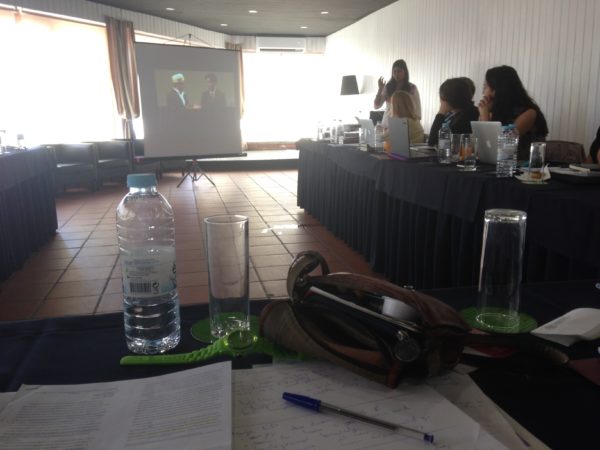
Photograph by Mette Gabler: Manju E P affiliated with Freie Universität, Berlin showing a clip form a Malayalm film in connection with discussing the paper: “Cinema within Cinema: Self-Refelctive/Self-Erasing Nature of Malayalam Cinema”.
Seonyoung Seo und Sebastian Sons
Im Rahmen der von der Humboldt-Universität zu Berlin in Zusammenarbeit mit der University of Singapore vom 24.-26. Mai 2016 organisierten Konferenz „Diversity Encounters: Intersectional and post-colonial perspectives“ präsentierte Sebastian Sons, Doktorand bei Frau Prof. Dr. Nadja-Christina Schneider, gemeinsam mit der Doktorandin Seonyoung Seo von der Universität aus Singapur Teile seiner Forschungsergebnisse. Beide nahmen an den so genannten „Trouble Shooting Labs“ teil, in denen jeweils ein Doktorand aus Deutschland sowie aus Singapur in intensiven Vorarbeiten Gemeinsamkeiten und Unterschiede ihrer Forschungsprojekte erarbeiteten und diskutierten. Vor allem methodische Herangehensweisen, theoriebezogene und empirische Herausforderungen und Erfahrungen wurden evaluiert. Während sich Sebastian in seiner Dissertation mit den Mediendiskursen um pakistanische Arbeitsmigrant_innen nach Saudi-Arabien beschäftigt, forscht Seonyoung zu nepalesischen Migrant_innen in Südkorea. In beiden Projekten nehmen der Zugang zu Eliten und der öffentliche Diskurs über das Phänomen Migration eine signifikante Bedeutung ein, wenngleich sich die methodische Herangehensweise und die lokalen Gegebenheiten doch deutlich voneinander unterscheiden. Beide Studien widmen sich der zeitgenössischen Diskussion um Arbeitsmigration, die in den Projekten als historisch bedeutsame Form der Mobilität und der transkulturellen Verknüpfung in Asien und dem Nahen und Mittleren Osten definiert wird. Basierend auf dieser Ausgangsthese analysieren beide Wissenschaftler die Auswirkungen der Migrationssysteme in den Aufnahmeländern Korea und Saudi-Arabien sowie in den Entsendeländern Nepal und Pakistan.
Daraus ergaben sich in der Diskussion einige signifikante Überschneidungen und Unterschiede in der Forschungsarbeit: Beide Projekte widmen sich Fragen nach Identitätskonstruktionen von Diasporagesellschaften, transnationalen und transkulturellen Netzwerken zwischen Empfänger- und Entsendeländern sowie dem Einfluss von Migration auf die jeweiligen Heimatländer. Während Sebastian die strategischen Ansätze, die Inhalte sowie die Debatten der jeweiligen Medienakteure über Migration wie Vertreter der Zivilgesellschaft und Journalisten analysiert, vertieft sich Seonyoung in ihrer Arbeit mehr darauf, die Selbstdefinition der nepalesischen Migrant_innen in Korea herauszuarbeiten und beschäftigt sich mit deren multiplen transnationalen Zugehörigkeiten, ihren unterschiedlichen kulturellen Affinitäten und ihren daraus erwachsenen hybriden Identitäten. Damit tragen beide Wissenschaftler zur akademischen Diskussion um sozialen Wandel in Zeiten der Globalisierung bei, in denen die Auffassung des Containerdenkens in nationalstaatlichen Kontexten zunehmend obsolet geworden ist.
Für beide Nachwuchswissenschaftler entwickelte sich aus den vorbereitenden Gesprächen und der gemeinsamen Präsentation eine intensive und konstruktive Diskussion, in der wesentliche Forschungsparallelen bei Fragen der Netzwerkbildung, Interviewführung und Öffentlichkeit trotz der verschiedenen regionalen Kontexte festgestellt wurden. Seonyoung und Sebastian empfanden die Mitwirkung am Trouble Shooting Lab als eine neue Forschungserfahrung, um die Kontakte mit anderen Wissenschaftlern zu intensivieren, neue Perspektiven zu erlangen und sich über Gemeinsamkeiten und Unterschiede in der täglichen Arbeit auszutauschen.



